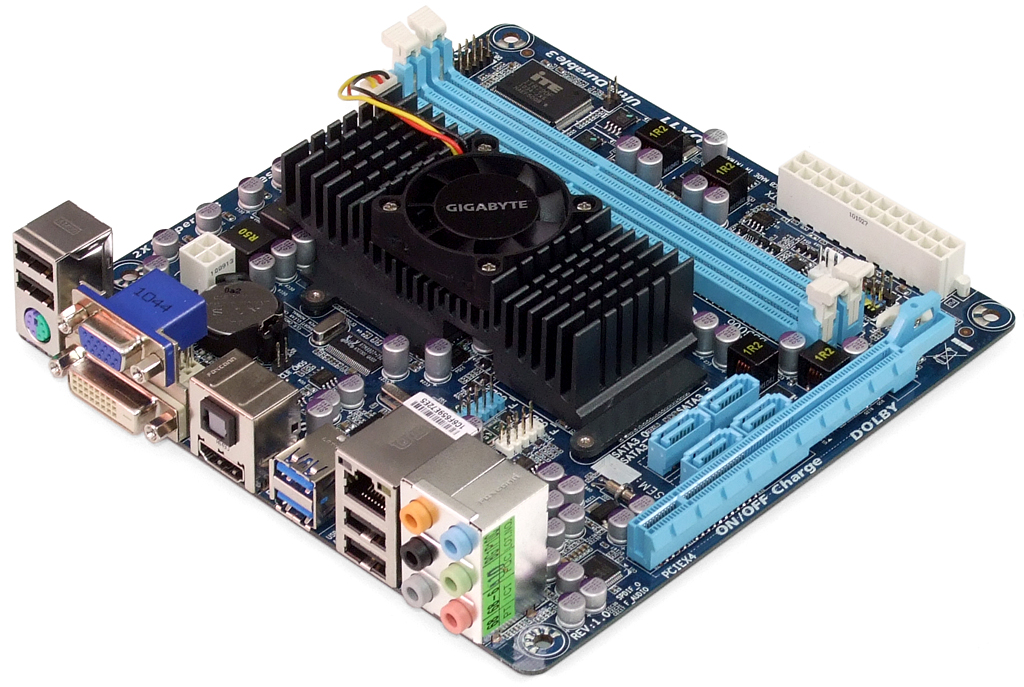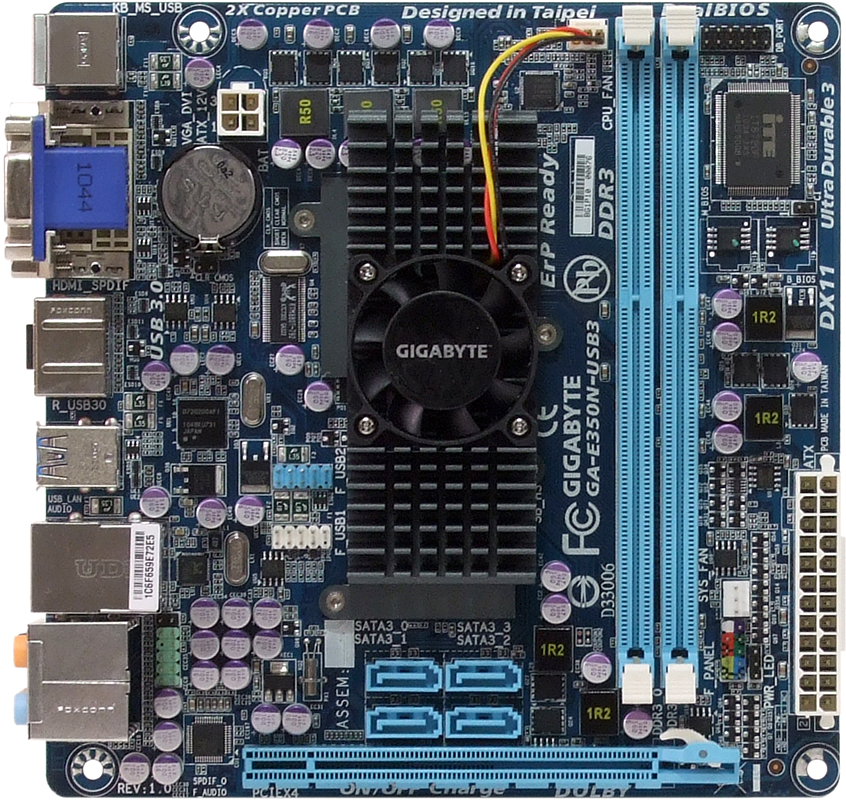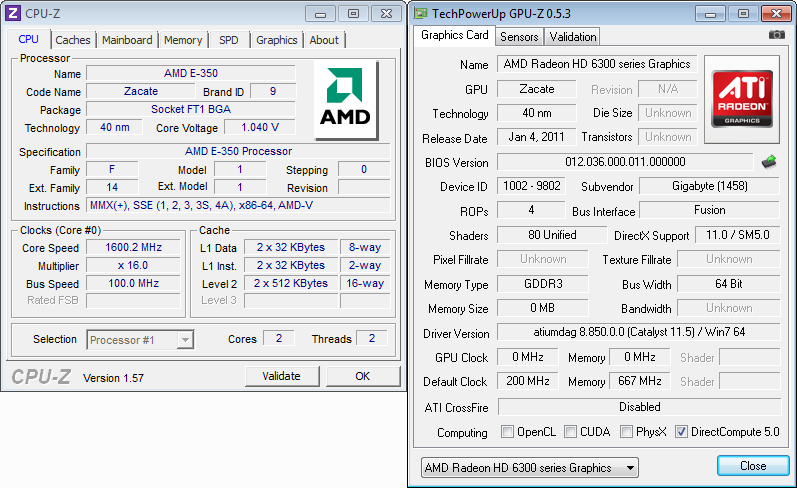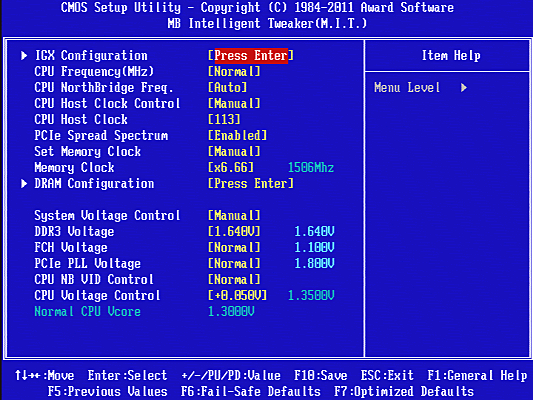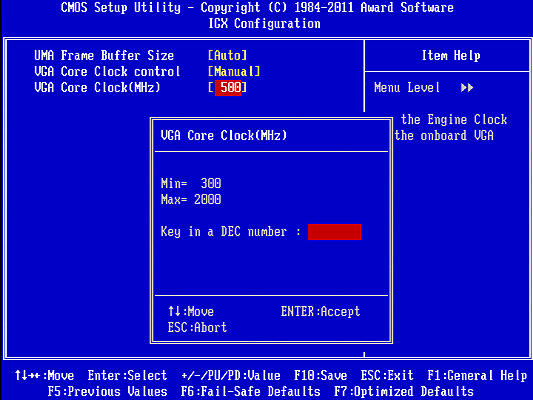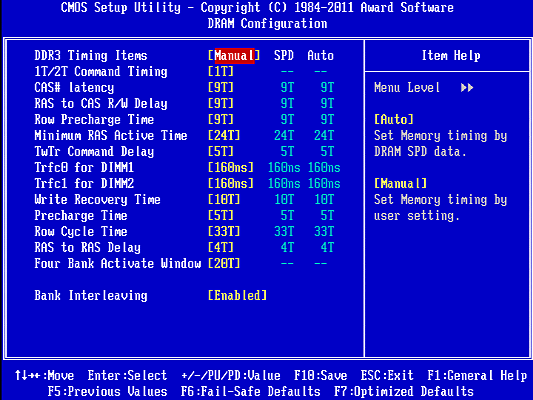The Brazos Round-Up: Eight AMD E-350-Based Motherboards
AMD’s Brazos platform, driven by the Zacate APU, offers a lot of performance per watt. It comes up short on features, though. Eight manufacturers try to change that perception by adding slots, controllers, and even overclocking in a couple of cases.
Gigabyte GA-E350N-USB3
The E350N-USB3 hits the middle of the market in features, having two USB 3.0 ports on the rear (but none for the front-panel), four SATA (but no eSATA) ports, and overclocking capability (but no Wi-Fi).
Gigabyte even addresses the legacy monitor and speaker markets with a VGA connector and six audio jacks. We’d have preferred anything else to the VGA connection. eSATA would have worked, or more USB ports, which are already supported by the underlying hardware. Switching from DVI-D and VGA to DVI-I and an adapter would have added cost, however.
The fan-cooled heat sink makes particular sense when paired with the E350N-USB3’s overclocking aspirations, as does its separate 4-pin CPU power connector.
Gigabyte’s minimal installation kit should be adequate for the typical mini-ITX build and nothing more, since it includes only two SATA cables.
E350N-USB3 Tuning
Gigabyte’s adherence to AMD’s reference frequency is nearly perfect at default settings. The board also detected our memory’s DDR3-1333 CAS 9 SPD values and used the appropriate settings, as seen in GPU-Z’s 667 MHz memory clock.
The APU reference clock is adjustable up to 120 MHz, slightly exceeding the clock ceiling most users will find for the E350. More voltage helps, but it’s unlikely anyone will need anything close to its 0.6 V maximum increase.
Other voltage limits include 2.10 V maximum for DRAM and 1.60 V for the chipset, again well beyond the settings most tuners will actually find useful.
Gigabyte also allows overclocking of the integrated Radeon HD 6310 graphics processor. We used default settings for our benchmarks to see how it would compete against other products at the same settings.
Gigabyte allows primary and secondary timings to be adjusted by the end-user for performance optimization. We again left these at stock to make the benchmarks fair.
Get Tom's Hardware's best news and in-depth reviews, straight to your inbox.
-
gameworm The Zotac board actually is available on NeweggReply
http://www.newegg.com/Product/Product.aspx?Item=N82E16813500068
Only problem is that it is $160 instead of $130
Otherwise very nice roundup. I've been thinking of using one of these for a server/NAS. -
noob2222 Odd timing for the roundup, Llano just came out, these will be discontinued asap.Reply
Not good for much save storage, but that wasn't tested. Would have much rather see an A8 board roundup since they are on newegg now. Picked up one myself for my htpc/storage setup. -
Mathos noob2222Odd timing for the roundup, Llano just came out, these will be discontinued asap.Not good for much save storage, but that wasn't tested. Would have much rather see an A8 board roundup since they are on newegg now. Picked up one myself for my htpc/storage setup.Reply
Uh no, Brazos is bast on the Bobcat core which is a low power version of Bulldozer. These are meant for ultra portables and netbooks, nettops, ultrathin notebooks and the likes.
Llano is the entry level desktop APU until they switch from Stars cores on those to the newer bulldozer cores. -
noob2222 mathosUh no, Brazos is bast on the Bobcat core which is a low power version of Bulldozer. These are meant for ultra portables and netbooks, nettops, ultrathin notebooks and the likes.And yet this roundup is .... desktop boards.Reply
And brazos has nothing in common with bulldozer. -
BulkZerker mathosUh no, Brazos is bast on the Bobcat core which is a low power version of Bulldozer. These are meant for ultra portables and netbooks, nettops, ultrathin notebooks and the likes. Llano is the entry level desktop APU until they switch from Stars cores on those to the newer bulldozer cores.Reply
noob2222And yet this roundup is .... desktop boards. And brazos has nothing in common with bulldozer.
Net TOP. Meaning a low power ITX board. Brazos is merely a stopgap till AMD has the tooling to kick out tons of BD cores. Though I will agree this roundup is a bit late it is at least thorough. -
cangelini gamewormThe Zotac board actually is available on Newegghttp://www.newegg.com/Product/Prod 6813500068Only problem is that it is $160 instead of $130Otherwise very nice roundup. I've been thinking of using one of these for a server/NAS.Reply
Good call--that board only recently became available, after this story was scheduled to be published. We've since updated the conclusion and price chart to reflect the market as of July 4th, 2011.
Cheers,
Chris -
GaMEChld BulkZerkerNet TOP. Meaning a low power ITX board. Brazos is merely a stopgap till AMD has the tooling to kick out tons of BD cores. Though I will agree this roundup is a bit late it is at least thorough.Reply
Brazos is NOT a stopgap, it is meant for very low power applications. It's basically AMD's take on Atom style devices. Bulldozer is not meant to scale to this low power envelope. That's why there are already plans for Brazos successors. Ontario/Zacate will be replaced by Khrishna/Wichita. Llano will be succeeded by Trinity, which is Bulldozer based. Zambezi is supposed to be succeeded by something called Komodo, which I haven't read much about. -
silverblue Trinity and Komodo are both Enhanced Bulldozer. As such, Trinity will not be using Zambezi cores.Reply -
Well, aside from a few bits about Brazos being a stop-gap based on Bulldozer being wrong, the basic premise of "odd timing for a Brazos roundup" holds true.Reply
Llano for laptops is out-freaking-standing, Llano for desktops is amazing for cheap OEM-built desktops and small form-factor HTPCs. TBH, it shouldn't excite much of anyone else, nor was it intended to replace Phenom II + dGPU for enthusiasts.
